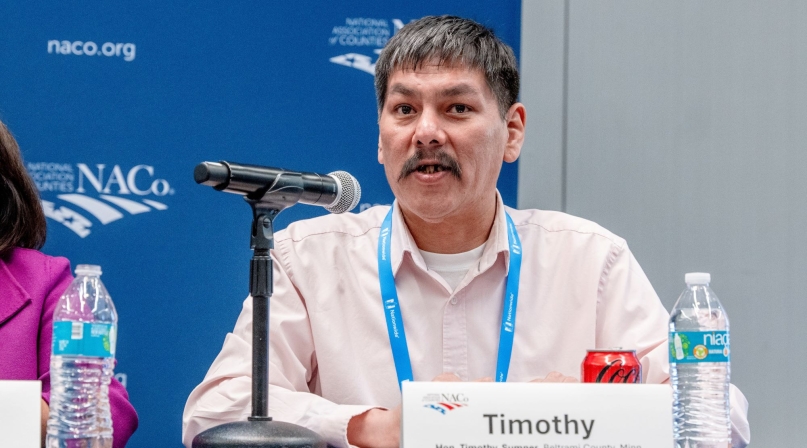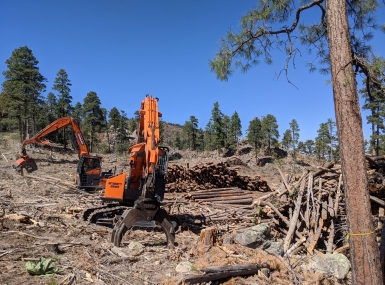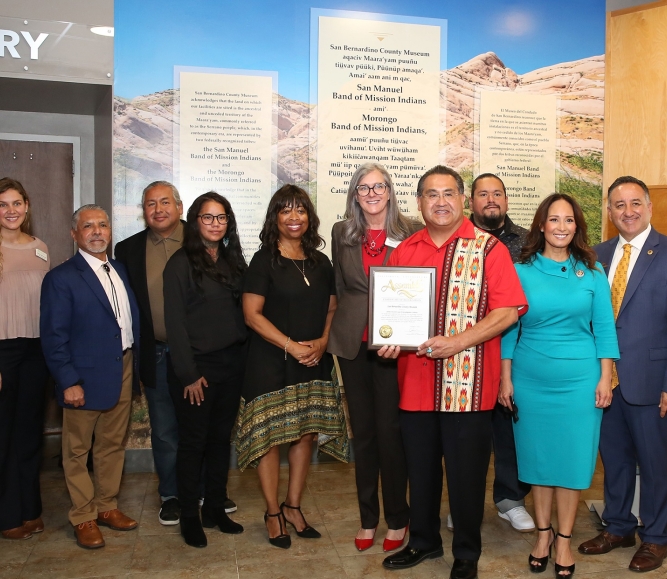Counties and tribes partner to fix shared problems

If you’ve seen one county, you’ve seen one county, and if you’ve seen one tribe, you’ve seen one tribe, said Coconino County, Ariz. Supervisor Lena Fowler, a member of the Navajo Bitter Water Clan. For county and tribal governments to best address the number of issues they overlap on — including land use planning, infrastructure development and emergency services — they must work to better understand how the other operates, according to panelists March 2 at the Tribal Policy 101: The Past, Present and Future of County and Tribal Relations workshop at NACo’s Legislative Conference.
Beltrami County, Minn. Commissioner Tim Sumner, who is also a member of the Red Lake Nation, is currently leading Minnesota county collaborations with the state’s sovereign tribes, dealing with issues ranging from land transfers and cannabis to child protection and property tax. Sumner said state associations often have stronger relationships with tribal nations than local governments do, and encouraged counties to look to their state associations on how to foster a closer relationship with tribal nations in their jurisdiction.
“I think inroads are happening, and I think it all starts with having small conversations, really talking about the bread-and-butter issues that really affect counties,” Sumner said. “When it comes to health and human services, in the state of Minnesota, we have a really archaic system that counties are having a difficult time managing, tribes are having a difficult time managing, so we agree we need to address this at the state level, so having that partnership really helps, having that added voice to those conversations.”
In working with tribal nations, it’s important for county officials to know how they operate, and the best way to do that is it to sit in on their tribal council session meetings, and also to extend that same invitation for tribal leaders to sit in on county meetings, said Apache County, Ariz. Supervisor Joe Shirley, Jr., who is also a former president of the Navajo Nation.
Cass County, Minn. has found success through coordinating joint meetings with the tribal nation in its area — the two entities switch off hosting and discuss land transfers, law enforcement agreements and other overlapping issues, according to Sumner.
“If the council delegates and chapter officials can be invited and be a part of the county government meetings, where ideas are exchanged, where resolutions are talked about [that would be beneficial],” Shirley said. “Knowing how the county government is set up, talking about the relation to the state government, and how much money there is to deliver services for law enforcement, for roads, for education, for elections — just the left hand knowing what the right hand is doing, and vice versa, I think that’s a good way to be.”
If a solid “government-to-government relationship” is built, counties and tribal nations can “pretty much tackle any problem out there,” according to Sonoma County, Calif. Supervisor David Rabbitt.
“When you do sit down to discuss these things and try to ‘negotiate’ a solution, it is a negotiation, and that’s different for local electeds, especially if there’s a development, for instance, involved,” Rabbitt said. “Usually, [counties] are the ones laying out the conditions of approval, and ‘You must do this, this, this and this’ … but you need to sit down and figure out together how you can achieve each other’s goals and understand what those points are along the way that are hiccups in the road.”
When Twin Arrows Casino was built in Coconino County, tribal nations worked with the county on the comprehensive plan and throughout the construction process, according to Fowler.
One of the elements that was important to the tribal nations was that the casino wouldn’t have bright lights, because the Native communities value having a “dark sky,” according to Fowler, who lives on Navajo Nation.
“All the glittering lights are very disruptive to the way that we do our ceremonies,” Fowler said. “Tribes value dark skies and really maintaining a natural environment for people, as well as wildlife.”
Many tribal members don’t have a state-recognized birth certificate, because they were born at home or before Native Americans were recognized as citizens of Arizona, so Coconino County brought together state legislators and Arizona’s 24 tribal nations to change the statute requirement from having seven forms of identification to two, in order to obtain a delayed birth certificate, Fowler said.
Another barrier with identification is that when Native Americans were forced into government-funded, often church-run, “assimilation” boarding schools in the 19th and 20th centuries in the United States, their records often referred to them with an “Americanized” name given to them that was different from their native one, making it more difficult to show records with a singular name over time. Fowler encouraged county officials to reach out to local tribal nations to determine what obstacles they’re facing, like documentation, and how they can help.
“…we’re trying to really work even more to make sure that our Native tribes are registered and they have their delayed birth certificate,” Fowler said.
Every tribal nation, like any other type of local government, is different, Fowler said. County officials must learn the different ways in which the tribal nations in their jurisdiction operate — how they communicate, what their protocols are, who their leaders are and what their role looks like — just like how they would within their own municipalities, according to Fowler. Native Americans are often distrustful of government, and building a mutually respectful relationship based on a genuine interest to learn is important, she added.
“When we talk about intergovernmental agreements, we do that with municipalities as well,” Fowler said. “We sit down, we get to know them, we get to find out, ‘What is their planning and zoning? Where are they?’ And it’s the same with the tribes, and then each tribe is set up differently.
“… You’ve got to think about studying the land. How is it set up? What era did the tribe become a tribe? And what status do they have? So, you’ve got to do your homework, just the way we do our homework with the cities and municipalities that are within our county.”
Related News

Counties search for footing amid federal workforce cuts
Staffing reductions in the federal land management agencies are upsetting the intergovernmental balance in public lands counties.

County Countdown – March 25, 2025
Every other week, NACo's County Countdown reviews top federal policy advocacy items with an eye towards counties and the intergovernmental partnership. This week features budget reconciliation, FY 2025 funding and more.

NACo Legal Advocacy: San Francisco v. Environmental Protection Agency (EPA)
San Francisco v. Environmental Protection Agency (EPA) has implications for the ability of county governments that own and operate wastewater treatment facilities to comply with National Pollutant Discharge Elimination System (NPDES) permit requirements.
County News
County museum works with tribes to portray evolution of community’s history

